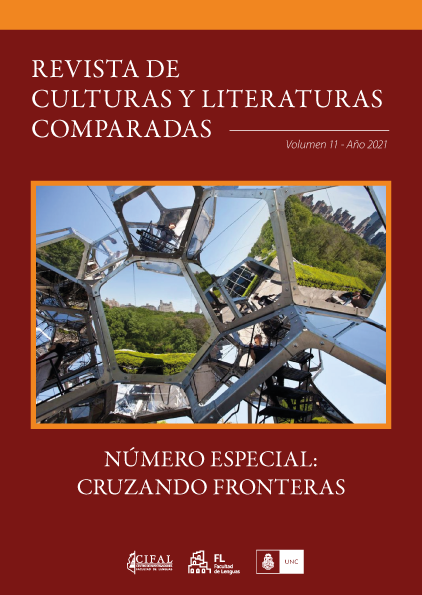Nuevos itinerarios de lectura: la novela gráfica y el cruce de géneros
Keywords:
graphic novel, intermediality, transmediality, intertextual readerAbstract
This work is part of research projects in the field of the UNRC interested in the study of literary discourse, its approaches, and its pedagogical and methodological implications. From the perspective of foreign languages, these projects define their objectives based on the relationship between the young reader and literature. For this reason, it is necessary, first, to characterize the literary texts that circulate today, to inquire about rewritings, re-readings and responses especially to canonical texts. The dialogic relationship between the texts enshrined in the literary tradition and contemporary reinterpretations allow us to construct a theoretical discourse in a context of profound social and cultural changes that condition understanding, tastes, aesthetic sensibility, our appreciations of culture and culture. our ways of reading. Concepts such as intertextuality, parody, intermediality and transmediality appear recontextualized through the appearance of diverse types of literary discourses. Within the emerging literatures that result from an implicit or explicit border crossing (linguistic, gender, media and supports), this presentation will analyze the graphic novel Heart of Darkness by the illustrator Catherine Anyango, and the writer-adapter David Mairowitz. In it, the construction of a sequential discourse is evidenced together with an interesting game between the image and the word. The resignification of Conrad's novel is based on the use of a variety of visual and artistic resources that provoke the construction of multiple meanings.
Downloads
References
Amo, José Manuel. “El papel del álbum en el desarrollo del intertexto lector.” Campo Abierto: Revista de Educación 28 (2005): 61-80.
Bland, Janice. Children’s Literature and Learner Empowerment. London: Bloomberry Academic, 2013.
Carter, Roland y John McRae. The Routledge History of Literature in English. Britain and Ireland. 2nd Ed. London and New York: Routledge, 2001.
Conrad, Joseph. Heart of Darkness & Other Stories. 1899. London: Wordsworth Classics, 1999.
Eisner, Will. Comics & Sequential Art. Tamarac, Fla: Poorhouse Press, 2000. Faber, Michel. “Michel Faber weighs up a graphic novel version of Conrad's”. The Guardian, 25 Sep 2010. Web.
Genette, Gerard. Palimpsestos. La Literatura en segundo grado. Madrid: Taurus, 1989.
Gibson, Mel. “Graphic Novels, Comics and Picture Books”. The Routledge Companion to Children’s Literature. Ed. David Rudd. London: Routledge, 2010.
Harvey, Robert C. “Comedy at the Juncture of the Word and Image: The Emergence of the Modern Magazine Gag Cartoon Reveals the Vital Blend”. The Language of Comics: Word and Image. Ed. Robin Varnum y Christina T. Gibbons. Jackson: University Press of Mississippi, 2001. 75–96.
Hutcheon, Linda. A Theory of Parody. The Teachings of the Twentieth-century Art Forms. Urbana and Chicago: University of Illinois Press, 2000.
McCloud, Scott. Understanding Comics: [the Invisible Art]. New York: Harper Perennial, 1994.
Rajewsky, Irina. “Intermediality, Intertextuality, and Remediation: A Literary Perspective on Intermediality”. Intermédialité - Historie et théorie des arts, des lettres et des techniques 6 (2005): 43-64.
Stein, Daniel. “Comics and Graphic Novels”. Handbook of Intermediality: Literature - Image - Sound - Music. Ed. Gabriele Rippl. Berlin/Boston: De Gruyter, 2015. 420-438.
Tew, Phillip y Alex Murray. The Modernism Handbook. Continuum Books, 2009.
Published
Issue
Section
License

This work is licensed under a Creative Commons Attribution-NonCommercial-NoDerivatives 4.0 International License.
Aquellos/as autores/as que tengan publicaciones con esta revista, aceptan los términos siguientes:
a) Los/as autores/as conservarán sus derechos de autor y garantizarán a la revista el derecho de primera publicación de su obra, el cual estará simultáneamente sujeto a la Licencia de reconocimiento de Creative Commons.
b) La cesión de derechos no exclusivos implica que la publicación de los artículos en la presente revista no quita la posibilidad o el derecho al autor/a de publicar su obra de manera posterior en otras revistas u órganos editoriales y la autorización por parte de los/as autores/as para que el trabajo sea depositado en los repositorios institucionales, tales como el Portal de Revistas de la Universidad Nacional de Córdoba.



